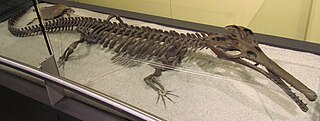
Champsosaurus is an extinct genus of crocodile-like choristodere reptile, known from the Late Cretaceous and early Paleogene periods of North America and Europe (Campanian–Paleocene). The name Champsosaurus is thought to come from champsai, (χαμψαι) said in an Ancient Greek source to be an Egyptian word for "crocodiles", and sauros, (σαύρος) Greek for "lizard". The morphology of Champsosaurus resembles that of gharials, with a long, elongated snout. It was native to freshwater environments where it likely preyed on fish, similar to living gharials.

Choristodera is an extinct order of semiaquatic diapsid reptiles that ranged from the Middle Jurassic, or possibly Triassic, to the Miocene. Choristoderes are morphologically diverse, with the best known members being the crocodile-like neochoristoderes such as Champsosaurus. Other choristoderans had lizard-like or long necked morphologies. Choristoderes appear to have been confined to the Northern Hemisphere, having been found in North America, Asia, and Europe, and possibly also North Africa. Choristoderes are generally thought to be derived neodiapsids that are close relatives or members of Sauria.

Simoedosaurus is an extinct reptile known from the Paleocene of North America, Europe and western Asia, and a member of the Choristodera, a group of aquatic reptiles that lived in the Northern Hemisphere from the Jurassic to the early Cenozoic.
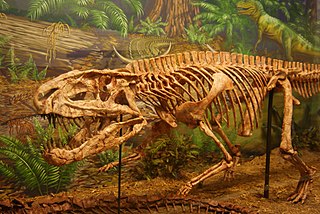
Rauisuchidae is a group of large predatory Triassic archosaurs. Some disagreement exists over which genera should be included in the Rauisuchidae and which should be in the related Prestosuchidae and Poposauridae, and indeed whether these should even be thought of as separate valid families. Rauisuchids occurred throughout much of the Triassic, and may have first occurred in the Early Triassic if some archosaurian taxa such as Scythosuchus and Tsylmosuchus are considered to be within the family.

Askeptosaurus is an extinct genus of askeptosauroid, a marine reptile from the extinct order Thalattosauria. Askeptosaurus is known from several well-preserved fossils found in Middle Triassic marine strata in what is now Italy and Switzerland.

Drepanosaurs are a group of extinct reptiles that lived between the Carnian and Rhaetian stages of the late Triassic Period, approximately between 230 and 210 million years ago. The various species of drepanosaurs were characterized by a bird-like skull, a barrell shaped body, and a horizontally narrow tail. A number of drepanosaurs had specialized grasping limbs and often prehensile tails similar to those of chameleons. Drepanosaurs are generally thought to have been arboreal (tree-dwelling), and probably insectivores. Some studies have alternately suggested fossorial (digging) and aquatic lifestyles for some members. Fossils of drepanosaurs have been found in North America and Europe. The name is taken from the family's namesake genus Drepanosaurus, which means "sickle lizard," a reference to their strongly curved claws.
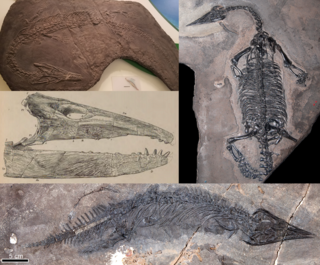
Thalattosauria is an extinct order of marine reptiles that lived in the Middle to Late Triassic. Thalattosaurs were diverse in size and shape, and are divided into two superfamilies: Askeptosauroidea and Thalattosauroidea. Askeptosauroids were endemic to the Tethys Ocean, their fossils have been found in Europe and China, and they were likely semiaquatic fish eaters with straight snouts and decent terrestrial abilities. Thalattosauroids were more specialized for aquatic life and most had unusual downturned snouts and crushing dentition. Thalattosauroids lived along the coasts of both Panthalassa and the Tethys Ocean, and were most diverse in China and western North America. The largest species of thalattosaurs grew to over 4 meters (13 feet) in length, including a long, flattened tail utilized in underwater propulsion. Although thalattosaurs bore a superficial resemblance to lizards, their exact relationships are unresolved. They are widely accepted as diapsids, but experts have variously placed them on the reptile family tree among Lepidosauromorpha, Archosauromorpha, ichthyosaurs, and/or other marine reptiles.

Endennasaurus is an extinct genus of thalattosaurian from the Upper Triassic of Italy. It was found in and named after the Endenna cave, composed of Zorzino Limestone in Lombardia.

Lazarussuchus is an extinct genus of amphibious reptile, known from the Cenozoic of Europe. It is the youngest known member of Choristodera, an extinct order of aquatic reptiles that first appeared in the Middle Jurassic. Fossils have been found in Late Paleocene, Late Oligocene, Early Miocene and possibly Late Miocene deposits in France, Germany, and the Czech Republic. Two species have been named: the type species L. inexpectatus ("unexpected") from the late Oligocene of France. and L. dvoraki from the early Miocene of the Czech Republic. It was not a large animal; with the total preserved body and tail length of L. inexpectatus being just over 30 centimetres. A complete specimen of Lazarussuchus with preserved soft tissue was found from the Late Paleocene of France, but has not been assigned to a species.
Langobardisaurus is an extinct genus of tanystropheid archosauromorph reptile, with one valid species, L. pandolfii. Its fossils have been found in Italy and Austria, and it lived during the Late Triassic period, roughly 228 to 201 million years ago. Langobardisaurus was initially described in 1994, based on fossils from the Calcare di Zorzino Formation in Northern Italy. Fossils of the genus are also known from the Forni Dolostone of Northern Italy and the Seefeld Formation of Austria.
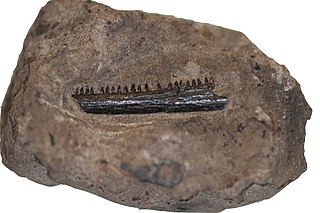
Cteniogenys is a genus of choristodere, a morphologically diverse group of aquatic reptiles. It is part of the monotypic family Cteniogenidae. The type and only named species, C. antiquus, was named in 1928 by Charles W. Gilmore. The holotype, VP.001088, was collected in the Morrison Formation, Wyoming in 1881 by William H. Reed. More specimens have been discovered since then, including specimens from the Late Jurassic of Portugal and Middle Jurassic of Britain, which have not been assigned to species.
Procerosuchus is an extinct genus of loricatan archosaur. Fossils have been collected from the Late Triassic Santa Maria Formation in Geopark of Paleorrota, Rio Grande do Sul, Brazil, which is Carnian in age. The genus was first described by the German paleontologist Friedrich von Huene in 1942.

Khurendukhosaurus is a genus of choristodere, a type of amphibious reptile. It is known from Lower Cretaceous rocks of Mongolia and Russia. Two species have been named. The type species, K. orlovi, was named in 1984 by Sigogneau–Russell and Efimov for the fragmentary postcranial skeleton PIN 3386/3. This specimen was discovered in the Albian-age Lower Cretaceous Khuren Dukh Formation Formation at Hüren Dukh, central Mongolia. The lake deposits at this site also contain fossils of the choristoderes Irenosaurus and Tchoiria. Other postcranial bones of K. orlovi have been found at this site as well.
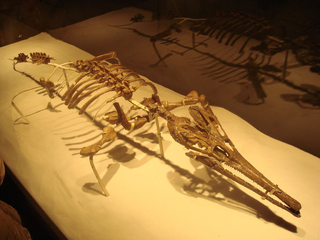
Tchoiria () is a genus of neochoristoderan reptile from the Early Cretaceous of Mongolia. The name Tchoiria comes from the city of Choir which is nearby to where the holotype was found. Tchoiria is thought to have a similar diet to another neochoristoderan reptile, Champsosaurus, due to morphology of the skull. It would hunt in freshwater environments, like the living gharials, where it would prey on many different types of fish and turtles.

Neochoristodera is a lineage of specialised crocodile-like fully aquatic choristodere reptiles. Noted for their long jaws and large size, these animals were predominant across the Northern Hemisphere, occurring in freshwater and coastal environments across the Cretaceous and early Cenozoic.
Stagonosuchus is an extinct genus of loricatan, or possibly a species of Prestosuchus. Fossils have been found from the Late Triassic Manda Formation in Tanzania that are Anisian in age.

Askeptosauridae is a family of thalattosaurs within the superfamily Askeptosauroidea. Fossils have been found from Italy, Switzerland, and China. Askeptosaurids are distinguished from other thalattosaurs by their long necks and narrow skulls.
The Besano Formation is a geological formation in the southern Alps of northwestern Italy and southern Switzerland. This formation, a thin but fossiliferous succession of dolomite and black shale, is famous for its preservation of Middle Triassic (Anisian–Ladinian) marine life including fish and aquatic reptiles. It is exposed in the Monte San Giorgio and Besano area. It is among the formations responsible for the area being designated as a UNESCO World Heritage Site. In Switzerland, it is also known as the Grenzbitumenzone. The Anisian-Ladinian boundary lies in the upper part of the Besano Formation.
Microcnemus is an extinct genus of lizard-like early archosauromorph reptiles from the Protorosauridae. Members of the genus lived during the Early Triassic period in Russia. Once believed to have been an ancestor to lizards, Microcnemus is now known to be one of the oldest members of the lineage that would eventually lead to archosaurs such as crocodilians and dinosaurs. The type species, M. efremovi, was named in 1940 by the German palaeontologist Friedrich von Huene.













